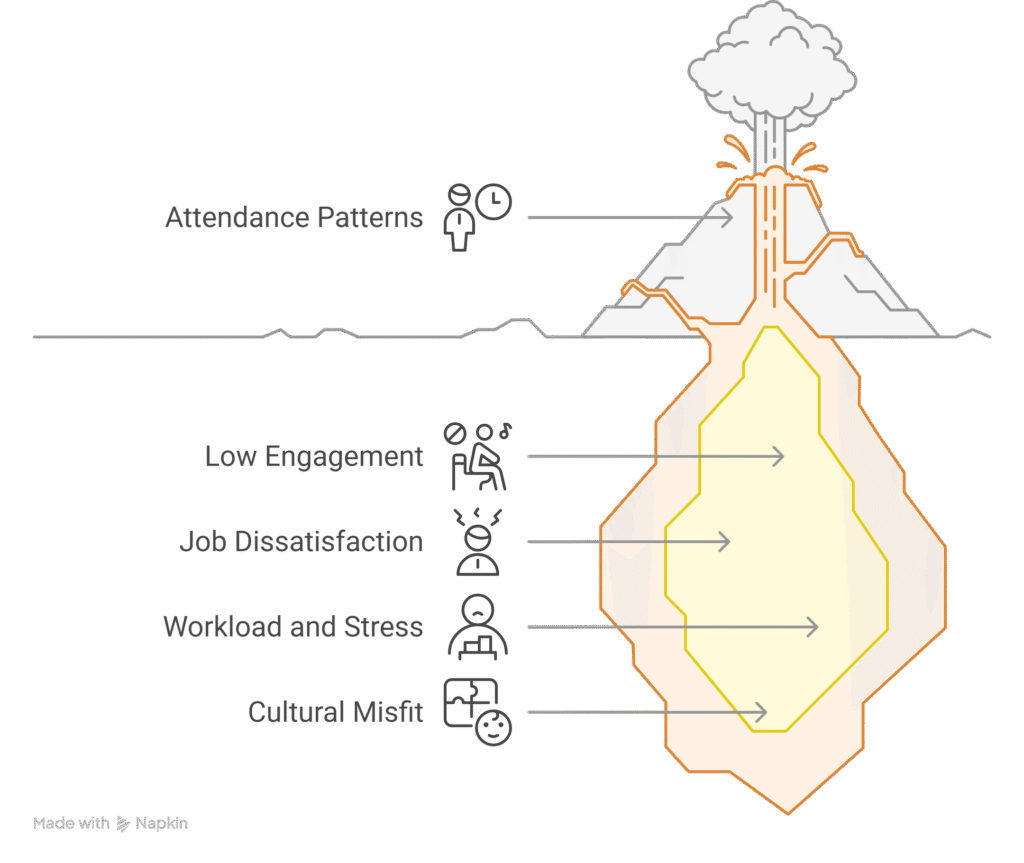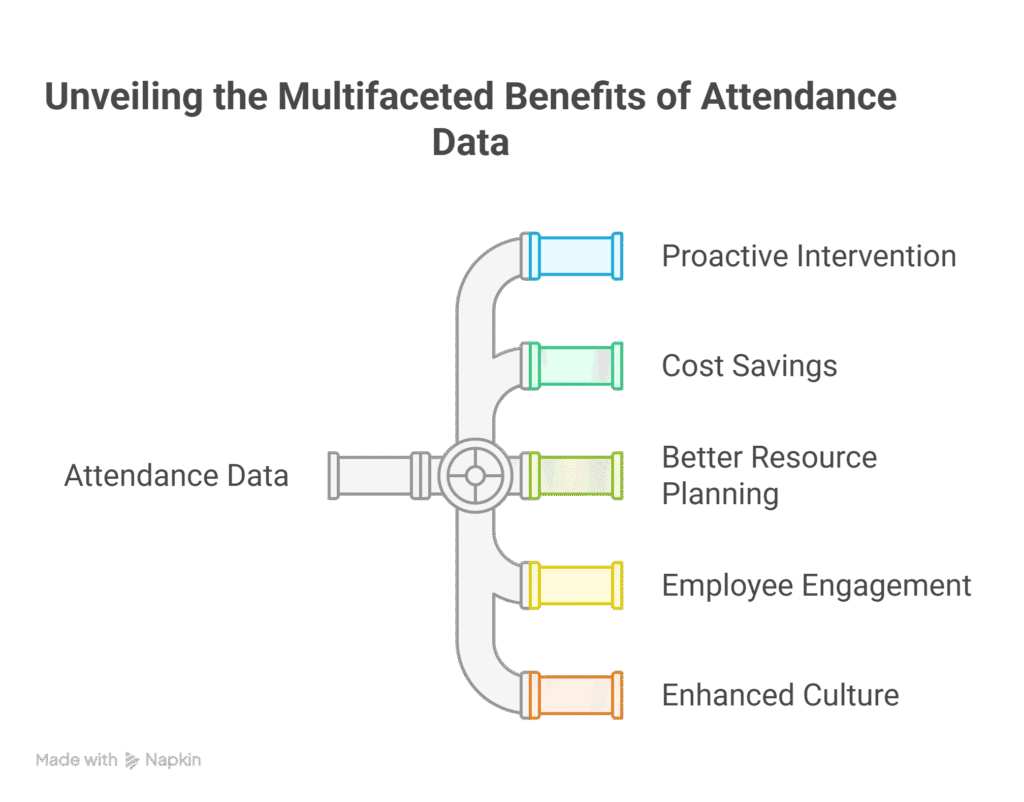
Table of contents
- Introduction
- What Are Attendance Patterns?
- How Attendance Patterns Predict Employee Attrition
- Benefits of Using Attendance Data to Predict Employee Attrition
- Traditional Management vs. Data-Driven Attendance Analysis
- Tools and Techniques for Analyzing Attendance Patterns
- Actionable Strategies to Reduce Employee Attrition
- Why It Matters: Creating a Better Work Environment
- Conclusion
Employee turnover can hurt a business in many ways. One effective method to stay ahead is to understand how attendance patterns help predict employee attrition. By analyzing the way employees show up—or do not show up—you gain valuable insights that can help improve retention and reduce turnover costs.
Introduction
All organizations rely on a dependable workforce. Excessive absenteeism and tardiness may indicate an underlying issue. Human Resources (HR) will use attendance data to look for trends. Attendance trends can be an early indicator of employee disengagement, and this can lead to employee attrition. When you understand how attendance trends can be used to predict employee attrition, you will be able to act quickly. This allows you to act quickly if you want to retain key talent.
What Are Attendance Patterns?
Attendance patterns refer to the common trends in how employees report to work. They include:
- Absenteeism: Missing days without a valid reason.
- Tardiness: Consistently arriving late.
- Leaving Early: Frequently departing before the scheduled time.
- Consistency: Regular and punctual vs. irregular attendance.
These patterns give a clear picture of an employee’s engagement and satisfaction. When such trends are identified early, HR teams can ask the right questions and explore the underlying causes.
How Attendance Patterns Predict Employee Attrition
Read More About : AI Attendance System with Face Recognition

When attendance patterns change, it can be a sign of potential attrition. Here’s how they link together:
- Low Engagement Signals: Employees who frequently miss work or arrive late might be less engaged. Low engagement is a strong predictor of turnover.
- Early Warning of Discontent: A sudden spike in absenteeism or tardiness may indicate job dissatisfaction. Early detection allows HR to address the issues before an employee decides to leave.
- Workload and Stress: High absence rates might point to burnout or excessive workload. Employees struggling with stress or job imbalance might eventually quit.
- Cultural Misfit: Consistent attendance issues can be part of a larger issue with company culture. If the work environment does not support employee needs, attrition is likely to increase.
By monitoring these patterns carefully, organizations can predict potential attrition. This insight then informs strategies to improve workplace satisfaction and retention.
Benefits of Using Attendance Data to Predict Employee Attrition
Using attendance data to predict attrition offers several advantages:

- Proactive Intervention: HR teams can address issues before they turn into resignations.
- Cost Savings: Reducing attrition lowers the cost of recruiting and training new employees.
- Better Resource Planning: Understanding attendance trends helps in planning staffing and workload distribution.
- Employee Engagement: When employees see that management is proactive about issues, it boosts morale and loyalty.
- Enhanced Culture: Solutions based on data lead to a healthier workplace culture.
Overall, tracking attendance patterns plays a vital role in improving employee retention.
Traditional Management vs. Data-Driven Attendance Analysis
Below is a table that compares traditional management methods with modern, data-driven analysis of attendance patterns:
| Aspect | Traditional Management | Data-Driven Attendance Analysis |
|---|---|---|
| Response Time | Reacts after attrition is evident | Proactively identifies trends before turnover |
| Employee Engagement | Relies on anecdotal evidence | Uses real data to understand employee behavior |
| Intervention Measures | Often delayed | Timely, based on continuous monitoring |
| Cost Efficiency | High recruiting and training costs | Lower costs through early intervention |
| Data Reliability | Subjective and sporadic | Objective, based on real-time data |
| Workplace Culture | May ignore underlying systemic issues | Helps identify and solve cultural problems |
This table illustrates how data-driven approaches are the tools that HR racing teams need to get ahead of attrition. Implementing these strategies can also improve retention strategies making for a happier workface.
Tools and Techniques for Analyzing Attendance Patterns
Modern technology has made it easier than ever to monitor attendance. Many organizations now use digital systems and advanced software to analyze attendance data. Here are some popular tools and techniques:
- Biometric Time Clocks: These devices record precise check-in and check-out times. They provide accurate, tamper-proof attendance data.
- Employee Scheduling Software: Advanced software not only tracks attendance but also identifies trends. It highlights anomalies like repeated tardiness or unexpected absences.
- Data Analytics Platforms: These tools crunch the numbers and generate insights. They help visualize trends and correlate attendance data with attrition patterns.
- Cloud-Based Attendance Systems: These systems store data securely in the cloud. They offer real-time monitoring and flexibility in accessing the data from anywhere.
By adopting these tools, companies can create a strong foundation for understanding how attendance patterns help predict employee attrition. Data-driven insights empower HR to make informed decisions.
Actionable Strategies to Reduce Employee Attrition
Once problematic attendance patterns are identified, the next step is to take action. Here are some strategies that have proven effective:
- Regular Check-Ins: Schedule regular meetings between employees and their managers. These meetings can uncover underlying issues early.
- Employee Surveys: Conduct surveys to gather feedback on job satisfaction. Use the results to make improvements in the work environment.
- Flexible Scheduling: Allow flexible work hours where possible. This can reduce stress and improve attendance.
- Wellness Programs: Implement programs to address employee well-being. Healthier employees are more likely to stay engaged and show consistent attendance.
- Professional Development: Offer training and growth opportunities. Employees who see a future with the company are less likely to quit.
- Recognize and Reward: Use recognition programs for consistent attendance. Rewards and positive feedback can boost morale and retention.
These strategies, combined with robust attendance analysis, lead to a more stable and committed workforce.
Why It Matters: Creating a Better Work Environment
Recognizing how attendance history supports and predicts employee turnover is not only about turnover, but also about improving the overall workplace. If issues are recognized at early stage, managers can take proactive measures to be able to address them and fortify their teams. This not only builds trust and loyalty from employees, which leads to increased levels of productivity and better morale.
Taking a data-driven approach to attendance will not only protect your financials; it will actually add value to the employee experience. It signals to your employees that your organization is deliberate and thoughtful in its approach, and ultimately cares about its people.
Conclusion
The relationship between attendance trends and employee turnover is not hard to see. Organizations can identify attendance trends and anticipate turnover. Businesses can adopt early intervention plans and achieve a greater likelihood of raising employee engagement while also saving a significant amount of money. Organizations that apply attendance data to a structured attendance system will have valuable insights generated from their workforce analyses. They may then apply strategic approaches to improve employee retention and, ultimately, a stronger workplace culture.
For the AI Camera You can Visit : IndoAI AI Cameras





